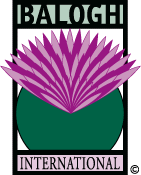

Presents
Missouri Botanical Garden Publications
Subject Index: to find a title, use your browser's edit/find feature. If you wish to order a title or can't find a title, just email us! or Return to Natural Sciences webpage. Please inquire about current pricing.
NEW Publications
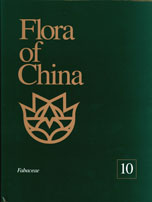
Flora of China, TEXT Volume 10. Fabaceae. Flora of China Editorial
Committee. 2010. ISBN: 9781930723917. 656 pp. Hardcover. $140.00
This volume entirely comprises the legume family (Fabaceae or Leguminosae), with
1,673 species in China, of which 690 are endemic, i.e., found nowhere else on
Earth. The legumes of China are divided into 29 tribes, starting with the
Cercideae, which include the disjunct redbuds (Cercis) and pantropical
Bauhinia, and finishing with the Fabeae, which include vetches (Vicia),
vetchlings (Lathyrus), lentil (Lens culinaris), and pea (Pisum
sativum). The largest legume genus in China is Astragalus, with 401
species (it is also the largest genus globally, with ca. 3,000 species),
followed by Oxytropis (133 species), Indigofera (79 species), in
which I. tinctoria and I. suffruticosa are sources of the dye
indigo, and Caragana (66 species).
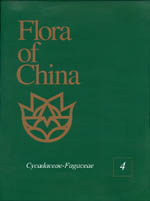
Flora of China.
Flora of China Editorial Committee.
The Chinese flora, with an estimated 30,000 species, is of immense scientific
and horticultural importance. Noteworthy, too, is the traditional medicine of
the country, which is based on its remarkable plant resources. Descriptions and
identification keys for this diverse flora, until now unavailable in English,
have been published over the past ten years in the Flora of China, in
conjunction with a separate series, the Flora of China Illustrations.
Eighteen of the total of 50 volumes have already been published, thanks to an
unprecedented and long-standing collaboration between Western and Chinese
scientists.
Text Volumes/Illustrations Volumes:
Volume 4. Cycadaceae through Fagaceae.
1999. ISBN: 9780915279708. 453 pp. Hardcover. $85.00
Volume 4.
Cycadaceae through Fagaceae. 2003. ISBN: 9780915279913. 419
pp. Illustrated. Hardcover. $95.00
Includes the Cycadaceae, Ginkgoaceae, Araucariaceae, Pinaceae, Sciadopityaceae,
Taxodiaceae, Cupressaceae, Podocarpaceae, Cephalotaxaceae, Taxaceae, Ephedraceae,
Gnetaceae, Casuarinaceae, Saururaceae, Piperaceae, Chloranthaceae, Salicaceae,
Myricaceae, Juglandaceae, Betulaceae, and Fagaceae.
Volume 5.
Ulmaceae through Basellaceae. 2003. ISBN:
9781930723276. 506 pp. Hardcover. $100.00
Volume 5.
Ulmaceae through Basellaceae. 2004.
ISBN: 9781930723405. 377 pp. Illustrated. Hardcover. $125.00
Includes the elms (Ulmaceae), rhoiptelea (Rhoipteleaceae), figs and mulberries (Moracae),
hemp and hops (Cannabaceae), stinging nettles (Urticaceae), aquatic, mosslike
herbs (Podostemonaceae), macadamias (Proteaceae), sandalwoods (Santalaceae),
olax (Olacaceae), opilia (Opiliaceae), mistletoes (Loranthaceae, Viscaceae ),
other parasitic plants (Rafflesiaceae, Balanophoraceae), pipe vines and wild
gingers (Aristolochiaceae), knotweeds, buckwheats, docks, and rhubarbs (Polygonaceae),
beet, spinach, and goosefoots (Chenopodiaceae), amaranths (Amaranthaceae),
four-o’clock (Nyctaginaceae), pokeweed (Phytolaccaceae), living stones (Aizoaceae),
mollugo (Molluginaceae), purslane (Portulacaceae), and basella (Basellaceae).
Volume 6.
Includes the pink (Caryophyllaceae), lotus (Nelumbonaceae), water lily (Nymphaeaceae),
fanwort (Cabombaceae), hornwort (Ceratophyllaceae), euptelea (Eupteleaceae),
trochodendron (Trochodendraceae), tetracentron (Tetracentraceae), katsura (Cercidiphyllaceae),
peony (Paeoniaceae), buttercup (Ranunculaceae), circaeaster (Circaeasteraceae),
and lardizabala (Lardizabalaceae).
Volume 7.
Menispermaceae through Capparaceae. 2008.
ISBN: 9781930723818. 511 pp. Hardcover. $125.00
Volume 7.
Menispermaceae through Capparaceae.
2009. ISBN: 9781930723887. 520 pp. Illustrated. Hardcover. $125.00
Eleven plant families are described in this volume. Among these, the Capparaceae
include the caper (Capparis spinosa); the Lauraceae include the main
source of camphor (Cinnamomum camphora), the spices cassia (C. cassia)
and cinnamon (C. verum), and the cultivated bay laurel (Laurus nobilis);
the Magnoliaceae include the Asian tulip tree (Liriodendron chinense),
found only in China and Vietnam, and some 110 species of magnolias that are
treated either in 12 separate genera or all in Magnolia; the
Myristicaceae include the source of nutmeg and mace (Myristica fragrans);
and the Papaveraceae include the horticulturally important poppies,
Meconopsis and Papaver, as well as the very diverse genus
Corydalis, which has 357 species in China.
Volume 8.
Brassicaceae through Saxifragaceae. 2001.
ISBN: 9780915279937. 506 pp. Hardcover. $85.00
Volume 8.
Brassicaceae through Saxifragaceae.
2003. ISBN: 9781930723160. 347 pp. Illustrated. Hardcover. $115.00
Includes the mustard (Brassicaceae), mignonette (Resedaceae), horse-radish tree
(Moringaceae), bretschneidera (Bretschneideraceae), pitcher-plant (Nepenthaceae),
sundew (Droseraceae), stonecrop (Crassulaceae), and saxifrage (Saxifragaceae).
Volume 9.
Pittosporaceae through Connaraceae. 2003.
ISBN: 9781930723146. 496 pp. Hardcover. $100.00
Volume 9.
Pittosporaceae through Connaraceae.
2004. ISBN: 9781930723344. 205 pp. Illustrated. Hardcover. $115.00
Includes the pittosporum (Pittosporaceae), witch hazel (Hamamelidaceae),
eucommia (Eucommiaceae), rose (Rosaceae), plane or sycamore (Platanaceae), and
connarus (Connaraceae).
Volume 11.
Oxalidaceae through Aceraceae. 2008. ISBN:
9781930723733. 622 pp. Hardcover. $125.00
Volume 11.
Oxalidaceae through Aceraceae. 2009.
ISBN: 9781930723788. 648 pp. Illustrated. Hardcover. $140.00
Aceraceae include 99 species of maple; the Anacardiaceae contain the cashew nut
and mango; the Aquifoliaceae comprise 204 species of holly; the Buxaceae include
the boxwoods; the Celastraceae include Euonymus, several species of which
are ornamentals; the Euphorbiaceae, or spurge family, contain some 400 species
in 75 genera, including rubber, which is widely cultivated in tropical areas for
its latex; the Geraniaceae comprise mainly the cranesbills, including several
ornamental species; the Linaceae contain flax, which is cultivated for its stem
fiber and seed oil; the Rutaceae include the commercially important citrus
fruits as well as Sichuan pepper, Zanthoxylum; and the Simaroubaceae
include the tree of heaven, which is an invasive alien in some parts of the
world.
Volume 12.
Hippocastanaceae through Theaceae. 2007.
ISBN: 9781930723641. 534 pp. Hardcover. $125.00
Volume 12.
Hippocastanaceae through Theaceae. 2008.
ISBN: 9781930723795. 475 pp. Illustrated. hardcover. $125.00
Included in this volume: Hippocastanaceae comprises the horse chestnuts and
buckeyes; Sapindaceae, the soapberry family, includes the fruits lychee and
longan, and species valued for their wood; Balsaminaceae, the balsam family,
mainly comprises Impatiens; Rhamnaceae includes Rhamnus, once used
for making charcoal for gunpowder, and ornamental plants that contain yellow and
green dyes; Vitaceae contains the grapes and numerous other vines; Tiliaceae
includes the basswoods, lindens, or limes; Malvaceae contains Hibiscus,
cotton, and okra; Bombacaceae includes kapok; Sterculiaceae, the source of
chocolate, also yields timber; Actinidiaceae includes the edible kiwifruit; and
Theaceae includes many ornamental species of Camellia, as well as C.
sinensis, the source of tea.
Volume 13.
Clusiaceae through Araliaceae. 2007. ISBN:
9781930723597. 548 pp. Hardcover. $125.00
Volume 13.
Clusiaceae through Araliaceae. 2008.
ISBN: 9781930723801. 492 pp. Illustrated. hardcover. $125.00
Included in this volume: Clusiaceae, the mangosteen and St. John’s-wort family,
harvested for its wood, resin, fruits, seeds, and horticultural and medical
uses; Dipterocarpaceae, major canopy trees of lowland tropical forests;
Tamaricaceae or tamarisk family; Violaceae, the violets and pansies;
Flacourtiaceae, source of chaulmoogric oil, used to treat leprosy;
Passifloraceae, the passion flower family; Begoniaceae, 141 of its ornamental
begonias naturally occurring only in China; Thymelaeaceae, including the
ornamental shrubs Daphne and Edgeworthia used for the manufacture
of paper and medicines; Elaeagnaceae, oleaster and buckthorn family, with its
fruit trees and ornamental shrubs; Lythraceae, including purple loosestrife and
the ornamental crepe myrtles; Trapaceae, the water chestnuts; Rhizophoraceae or
mangrove family; Nyssaceae, containing the genus Camptotheca, source of
the anticancer drug camptothecin, and Davidia, the dove tree, which
naturally occurs only in China; Combretaceae, with shrubs, vines, and trees of
ornamental and medical use; Myrtaceae, including eucalyptus and fruit trees;
Melastomataceae, of value in medicine and horticulture; Onagraceae, including
willowherbs and evening primrose, used in medicine as well as for ornament; and
Araliaceae, with several economically important Chinese genera, notably,
Panax or ginseng.
Volume 14.
Apiaceae through Ericaceae. 2005. ISBN:
9781930723412. 581 pp. Hardcover. $115.00
Volume 14.
Apiaceae through Ericaceae. 2006. ISBN:
9781930723511. 725 pp. Illustrated. Hardcover. $125.00
Included in this volume: Apiaceae (or Umbelliferae), containing a number of
vegetables and herbs that are essential to the worlds cuisines such as anise,
carrot, celery, cilantro or coriander, cumin, dill, fennel, and parsley, as well
as several species used in traditional Chinese medicine. Clethraceae, the Lily
of the Valley Tree family. Cornaceae (and the related Garryaceae, Helwingiaceae,
Mastixiaceae, and Toricelliaceae), including the lovely white blossomed dogwood
trees. Diapensiaceae, a family of herbs and ornamental shrubs. Ericaceae, the
heath family, encompassing the glorious rhododendrons and azaleas, as well as
cranberries and bilberries.
Volume 15.
Myrsinaceae through Loganiaceae. 1996.
ISBN: 9780915279371. 387 pp. Hardcover. $85.00
Volume 15.
Myrsinaceae through Loganiaceae. 2000.
ISBN: 9780915279777. 325 pp. Illustrated. Hardcover. $95.00
Includes the Myrsinaceae, Primulaceae, Plumbaginaceae, Sapotaceae, Ebenaceae,
Symplocaceae, Styracaceae, Oleaceae, and Loganiaceae.
Volume 16.
Gentianaceae through Boraginaceae. 1995.
ISBN: 9780915279333. 479 pp.
Hardcover. $85.00
Volume 16.
Gentianaceae through Boraginaceae.
1999. ISBN: 9780915279692. 383 pp. Illustrated. Hardcover. $95.00
Includes the Gentianaceae, Menyanthaceae, Apocynaceae, Asclepiadaceae,
Convolvulaceae, Polemoniaceae, Hydrophyllaceae, and Boraginaceae.
Volume 17.
Verbenaceae through Solanaceae. 1994. ISBN:
9780915279241. 378 pp.
Hardcover. $85.00
Volume 17.
Verbenaceae through Solanaceae. 1998.
ISBN: 9780915279531. 426 pp. Illustrated. Hardcover. $95.00
Includes the large and economically important Verbenaceae, Lamiaceae, and
Solanaceae represented in China by nearly 1,000 species.
Volume 18.
Scrophulariaceae through Gesneriaceae.
1998. ISBN: 9780915279555. 449
pp. Hardcover. $85.00
Volume 18.
Scrophulariaceae through Gesneriaceae.
2000. ISBN: 9780915279845. 423 pp. Illustrated. Hardcover. $95.00
Includes the Scrophulariaceae, Bignonoiaceae, Pedaliaceae, Martyniaceae,
Orobanchaceae, and Gesneriaceae, represented in China by 1203 species, of which
800 are endemic.
Volume 22.
Poaceae. 2006. ISBN: 9781930723504. 752 pp. Hardcover. $140.00
Volume 22.
Poaceae. 2007. ISBN: 9781930723610. 949
pp. Illustrated. Hardcover. $140.00
Volume 23. Acoraceae through Cyperaceae. 2010. ISBN: 9781930723993. 528
pp. Hardcover. $125.00
Volume 24.
Flagellariaceae through Marantaceae. 2000.
ISBN: 9780915279838. 431 pp.
Hardcover. $85.00
Volume 24.
Flagellariaceae through Marantaceae.
2002. ISBN: 9781930723009. 449 pp. Illustrated. Hardcover. $115.00
Includes the Flagellariaceae, Restionaceae, Centrolepidaceae, Xyridaceae,
Eriocaulaceae, Bromeliaceae, Commelinaceae, Pontederiaceae, Philydraceae,
Juncaceae, Stemonaceae, Liliaceae, Amaryllidaceae, Taccaceae, Dioscoreaceae,
Iridaceae, Musaceae, Lowiaceae, Costaceae, Zingiberaceae, Cannaceae, and
Marantaceae.
Volume 25.
Orchidaceae. 2009. ISBN: 9781930723900. 570 pp. Hardcover. $125.00
Comprised entirely of the orchid family, or Orchidaceae, with 1,388 species in
China, of which 494 are endemic, i.e., found nowhere else on Earth. The orchids
of China include wild relatives of the source of the economically important
vanilla pod, as well as the well-known cultivated genera Cymbidium and
the slipper orchids, Cypripedium and Paphiopedilum. China has
hundreds of other horticulturally important orchid species in genera such as
Bletilla, Bulbophyllum, Calanthe, Coelogyne,
Dendrobium, Phalaenopsis, Pleione, and Vanda. This
volume is the only fully comprehensive and up to date, English-language account
of the wild orchids of China.

Manual
de
Plantas de Costa Rica.
B.E. Hammel, M.H. Grayum, C. Herrera, N. Zamora.
The Manual de Plantas de Costa Rica is a concise, illustrated
guide to all of the species of native, naturalized and commercially cultivated
vascular plants of this Central American country, which lies between Nicaragua
and Panama and is thus centered in isthmian Central America—a biogeographical
funnel between South and North America, densely rich in species and geological
history. The Manual is the first comprehensive Spanish-language account
of the Costa Rican flora. The work is presented in a series of several volumes.
Volumen I: Introducción. 2004. ISBN:
9781930723245. 299 pp. Hardcover. $40.00
This volume consists of five chapters dealing with the history of botanical
exploration in Costa Rica, the physical aspects of the country, and the
vegetation, in addition to the botanical novelties discovered during the
preceding 15 years. There is also a detailed description of the layout of the
treatment volumes and a complete list of literature cited is included at the
end, along with an appendix to scientific names. Chapters are illustrated with
numerous black and white photographs for a total of ca. 90 photos of botanists,
habitats, and plants. Eight pages of color plates are also included.
Volumen II: Gimnospermas y Monocotiledoneas (Agavaceae-Musaceae).
2003. ISBN: 9781930723221. 694 pp. Hardcover. $70.00
Nearly one half of the species in this volume are distributed among three large,
economically and ornamentally important families, the Araceae (Philodendron,
etc.) with 248 species, the Arecaceae (the palms) with 109 species, and the
Bromeliaceae (pineapple, etc.) with 195 species. A total of 1125 species of
monocots in 35 families are presented. Gymnosperms, of low diversity in the
tropics, with only five families and 13 species in Costa Rica that fit the
Manual’s general criteria of native, naturalized, or commercially
cultivated, are fully treated. Besides brief formal descriptions and informal
notes about each of a total of 40 families, 190 genera, and 1136 species of seed
plants, this identification manual contains keys to all the gymnosperm and
monocot families treated in the series, as well as to the genera and species
included within this volume. A total of 218 original line drawings and 40
black-and-white photographs illustrate the treatments.
Volumen III: Monocotiledóneas (Orchidaceae-Zingiberaceae).
2003. ISBN: 9781930723238. 884 pp. Hardcover. $70.00
Two large, economically and ornamentally important families, the orchids (Orchidaceae)
with 1318 species, and the grasses (Poaceae) with 488 species, account for more
than 95% of the species in this volume. Besides brief formal descriptions and
informal notes about each of a total of 10 families, 331 genera, and 1861
species of monocots, this identification manual contains keys to all the genera
and species included within the volume. Finally, the treatments are illustrated
with 377 line drawings and 10 black-and-white photographs.
Volumen VI: Dicotiledóneas (Haloragaceae-Phytolaccaceae).
2007. ISBN: 9781930723603. 933 pp. Hardcover. $125.00
Melastomataceae, with 303 species of mostly understory trees, is by far the
largest family in this volume. Together with the two next largest
families,Lauraceae (146 species) and Malvaceae (98 species), also of mostly
woody plants, these three families account for 40% of the species in the volume.
This identification manual includes brief formal descriptions and informal notes
about each of a total of 54 families, 296 genera, and 1396 species. Keys to all
the genera and species are also included. The treatments are illustrated with
343 line drawings, 54 black-and-white photographs, and 8 pages of color plates.
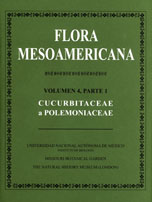
Flora Mesoamericana
The first major regional flora ever written in Spanish, Flora Mesoamericana is a
collaborative effort of the Missouri Botanical Garden, the Instituto de Biologia
of the National Autonomous University of Mexico, the Natural History Museum,
London, and numerous specialists world wide. In Spanish, the Flora describes,
for the first time, all the vascular plants growing in the southeasternmost
states of Mexico, including the Yucatan Peninsula, and all the Central American
republics. Due to be published in seven volumes.
Volume 1: Psilotaceae to Salviniaceae. 1995. ISBN:
9789683647009. 470 pp. Hardcover. $65.00
Covered in this volume are Psilotaceae,Salviniaceaeare, Pteridaceae,
Thelypteridaceae, Lomariopsidaceae, Polypodiaceae, and Grammitidaceae.
Volume 4(1): Cucurbitaceae a Polemoniaceae.
2009. ISBN: 9786070209017. 855 pp. Hardcover. $95.00
Volume 6: Alismataceae to Cyperaceae. 1994. ISBN:
9789683633101. 543 pp. Hardcover. $65.00
Covered in this volume are Alismataceae to Cyperaceae, 326 genera and 1891
species.
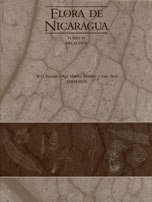
Flora
de Nicaragua.
W.D. Stevens, Olga Martha Montiel, Amy Pool, eds.
Flora de Nicaragua is a the first modern flora of that country and
the first complete flora of a Latin American country published in Spanish. About
23 years in the making, the Flora de Nicaragua describes
5,796 species in 1,699 genera in 225 families of seed plants. The largest family
is the Orchidaceae with 601 species. There were 175 contributors from 16
countries.
Tomo I-III. 2001. ISBN: 9780915279951. 2666 pp. 3 Volumes. Hardcover.
$350.00
The Flora is divided into Gymnosperms and Angiosperms, and within those groups
taxa are alphabetical. Families and genera have identification keys. Species
treatments include the place of original publication, general synonymy, a brief
description, habitat and distribution within the country, vouchers, phenology,
general distribution, and some well-established local names.
Tomo IV. Helechos.
2009. ISBN: 9781930723870. 349 pp. Hardcover. $109.00
Helechos is the fourth volume of the series Flora de Nicaragua. It
describes and illustrates 633 species of ferns in 114 genera. The three previous
volumes of the Flora were published in 2001 and included 5796 species in 1699
genera in 225 families of seed plants, native or naturalized.The publication of
this volume completes the flora of the vascular plants of Nicaragua.
Flora of the Venezuelan Guyana. Julian
Steyermark, Paul Berry, Bruce Holst, Kay Yatskievych.
The Flora of the
Venezuelan Guayana is the first full scientific account of a botanically
rich and geologically ancient part of South America. The
Venezuelan Guayana lies in the center of the
Guayana Shield and is dominated by massive
table mountains known as
tepuis. From these imposing mountains fall the
highest waterfalls in the world, such
as
Angel Falls
on
Auyán-tepui. It is a region of great beauty,
still largely pristine, which includes other diverse habitats such as the swamps
of the Orinoco Delta,
the upland
Gran Sabana, large extensions of lowland
tropical forest, and the peculiar white-sand savannas and shrublands of the
upper
Río Negro. More information about the
geography, history, vegetation, and conservation issues can be found in a
summary of Volume 1. Volume 9 will complete the
series.
Botanical explorations in the Guayana Shield region have resulted in the
recognition of hundreds of new species, dozens of new genera, and several new
families of
plants, many of them only known to occur there.
Volumes 2 through 9 contain the floristic treatments for the Venezuelan Guayana.
These provide full taxonomic descriptions for each family and genus. For each of
the nearly 9,400 species and their subordinate taxa, there is an entry that
provides information on the plant's habit, habitat, elevational range in the
flora area, detailed locality data, and common names and uses. Identifications
are facilitated by dichotomous keys to the genera, species, and infraspecies;
close to 5,000 species are illustrated by black-and-white line drawings,
at least one for each genus. The families are arranged alphabetically in two
main categories: the ferns and fern allies, and the seed plants.
Volume 1: Introduction. 1995. ISBN:
9780915279739. 363 pp., color plates, line drawings. Hardcover. $49.99
General introduction to the southeastern half of Venezuela that encompasses the
flora area, with chapters on geography, history of botanical exploration,
vegetation types, endemism, and conservation. Keys to the families of seed
plants are also provided.
Volume 2: Pteridophytes, Spermatophytes,
Acanthaceae-Araceae. 1995. ISBN: 9780915279746. 706 pp., color
plates, line drawings. Hardcover. $49.99
First of the alphabetical sequence of family treatments, beginning with ferns
and fern allies. Keys, descriptions, and illustrations of more than half the
species treated.
Volume 3: Araliaceae-Cactaceae. 1997. ISBN:
9780915279463. 792 pp., color plates, line drawings. Hardcover. $49.99
This volume continues the alphabetical sequence of family treatments, from
Araliaceae to Cactaceae. Keys, descriptions, and illustrations of more than half
the species treated.
Volume 4: Caesalpinaceae-Ericaceae. 1998.
ISBN: 9780915279524. 799 pp., color plates, line drawings. Hardcover. $49.99
This volume continues the alphabetical sequence of family treatments, from
Caesalpiniaceae to Ericaceae. 1329 species treated. 621 line drawings.
Volume 5: Eriocaulaceae-Lentibulariaceae.
1999. ISBN: 9780915279715. 833 pp., color plates, line drawings. Hardcover.
$49.99
This volume continues the treatment of the Spermatophyte families alphabetically
from Eriocaulaceae through Lentibulariaceae, a total of 29 families. The volume
treats 270 genera and 1304 species and includes 707 line drawings.
Volume 6: Liliaceae-Myrsinaceae. 2001.
ISBN: 9780915279814. 803 pp., color plates, line drawings. Hardcover. $49.99
This volume is richly illustrated with 657 black-and-white line drawings by
Venezuelan artist Bruno Manara, more than half of the 1,217 species treated and
one or more per genus. Included in the volume are the seed plant families
Liliaceae through Myrsinaceae.
Volume 7: Myrtaceae-Plumbaginaceae. 2003.
ISBN: 9781930723139. 765 pp., color plates, line drawings. Hardcover. $69.99
This volume describes the plants of a botanically rich and geologically ancient
part of northern South America, and is richly illustrated by Venezuelan artist
Bruno Manara. In this alphabetical sequence of family treatments, Volume 7
treats Myrtaceae to Plumbaginaceae. This includes the largest family in the
flora area, the Orchidaceae with 157 genera, 732 species, 341 drawings, a
two-page illustrated glossary, and four color photos on the back dust jacket.
Volume 8: Poaceae-Rubiaceae. 2004. ISBN:
9781930723368. 874 pp., color plates, line drawings. Hardcover. $69.99
This volume continues the alphabetical sequence of family treatments begun in
Volume 2, which treated ferns and their allies and the first 11 families of seed
plants. The current volume contains treatments of 17 families of seed plants,
arranged alphabetically from Poaceae through Rubiaceae. Within those families
are treated 244 genera and 1248 species. In addition, the volume includes 659
line drawings and endpaper maps.
The final volume in the series Flora of the Venezuelan Guayana, illustrated with
503 black-and-white drawings by Venezuelan artist Bruno Manara,covering over
half of the 971 species and one or more per genus. Included in the volume are
the seed plant families Rutaceae through Zygophyllaceae, a total of 48 families.